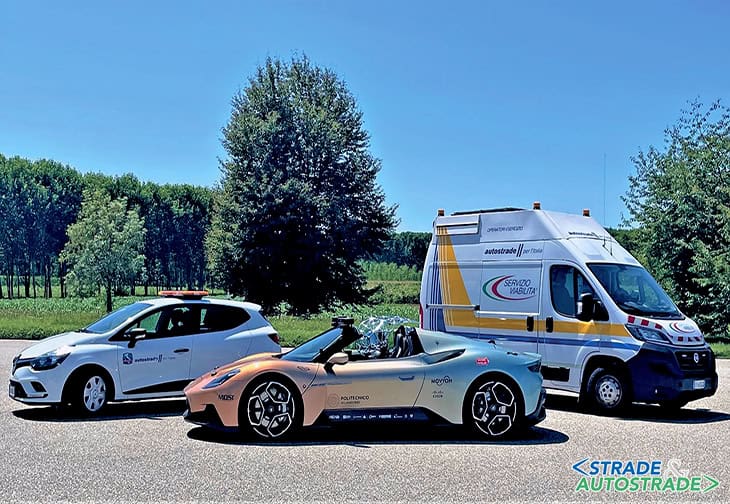![]() Per la versione in Italiano: https://www.stradeeautostrade.it/its-smart-road/sperimentazioni-guida-autonoma-a-traffico-aperto/
Per la versione in Italiano: https://www.stradeeautostrade.it/its-smart-road/sperimentazioni-guida-autonoma-a-traffico-aperto/
From simple operators to traffic orchestrators. This is how Movyon, the technological hub of the Autostrade per l’Italia Group and leader in Intelligent Transport Systems solutions, is redefining the future of mobility by developing innovative vehicle-infrastructure communication technologies that pave the way for increasingly safe and efficient autonomous driving.
The autonomous driving revolution in the road transport sector
The road transport sector is undergoing a major transformation: electrification, sharing mobility, new digital mobility services, connectivity and autonomous driving to name just a few of the ongoing changes. The latter encompasses the key trends in innovation we are witnessing: an autonomous vehicle will be connected, probably electric, and just as likely shared.
Autonomous driving is typically classified into levels, which are a function of the degree of automation and human involvement. These classifications are known as “levels of driving automation” and have been defined by the Society of Automotive Engineers (SAE) in the J3016 standard.
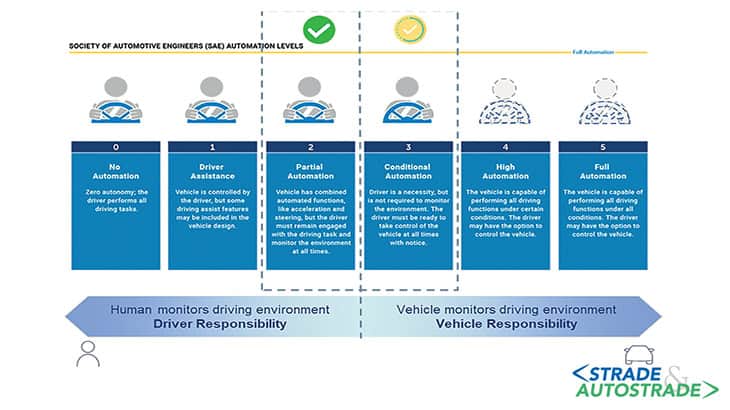
Most commercially available vehicles can operate with a level of driving automation of 2: under close supervision of the driver – who never takes their hands off the steering wheel or their eyes off the road – the vehicle automatically controls longitudinal dynamics (Adaptive Cruise Control) and lateral dynamics (Lane Keeping). Level 3 has been authorized in just a few countries, and only within specific scenarios (also known as Operational Design Domains or ODDs 1).
1 ODD – SAE 2021: Operating conditions under which a given driving automation system, or feature thereof, is specifically designed to function, including, but not limited to, environmental, geographical, and time-of-day restrictions, and/or the requisite presence or absence of certain traffic or roadway characteristics.
According to some studies, up to 18% of vehicles in circulation could be level 3 or higher in European countries by 2030 [1].
By eliminating misbehavior and distractions, the development and widespread adoption of autonomous driving will bring several benefits, including improved safety and smoother traffic flow, resulting in lower fuel consumption and emissions due to shorter travel times [2].
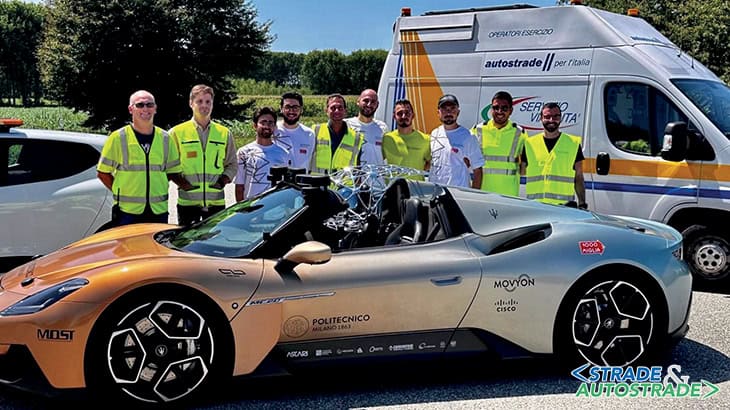
The challenges ahead
Public roads are extremely complex, varied and dynamic, and they are certainly not designed for autonomous driving. Moreover, the number of on-board sensors is limited and cannot always provide robust, reliable and accurate data. The biggest limitation therefore arises from relying exclusively on information gathered locally by the sensors on the vehicle.
When an autonomous vehicle encounters a situation that is not among the foreseen scenarios, it may require the driver to intervene and take control of the vehicle (i.e. takeover). If this occurs frequently, the overall experience is less reliable and less smooth for the driver, as well as less safe.
Advanced C-ITS autonomous driving services: precise-positioning solutions in GNSS-denied environments
These limitations can be overcome by enabling cooperative systems that facilitate data exchange between vehicles and infrastructure (V2I or Vehicle to Infrastructure communication), according to the Cooperative Intelligent Transport Systems (or C-ITS) paradigm. Motorway infrastructure is equipped with sensors and monitoring systems, as well as advanced traffic monitoring centers, giving it an overview or bird-view that keeps it up to date with the network status and allows it to provide additional information that would otherwise be unavailable to individual vehicles.
Movyon initiated a trial with the aim of conceiving and road-testing new advanced C-ITS services. These services aim to prepare the motorway network to welcome and support autonomous vehicles.
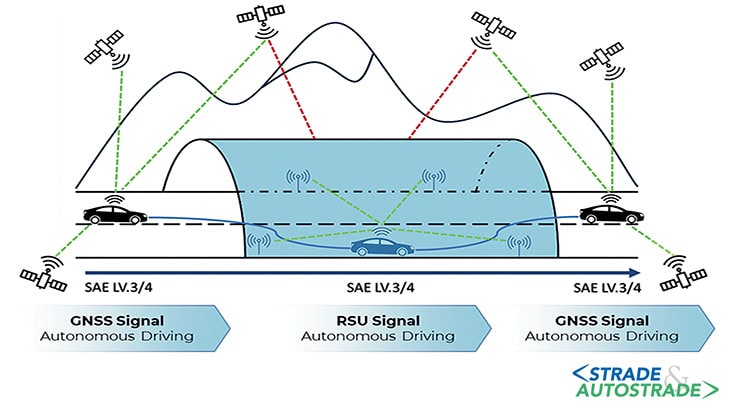
For the vehicle to make the correct driving decisions, perception, planning and control require very accurate knowledge of the vehicle position, as well as any hazardous objects or situations near it. Localization is therefore a key priority as the first piece of the functional architecture of an autonomous vehicle. Because of the complex orography of the territory, the Italian motorway network poses several challenges in this regard.
An advanced C-ITS positioning solution of the I2V type has therefore been conceived, designed and tested to supplement or replace precision on-board location sensors (e.g. GNSS RTK). This solution will allow vehicles with high levels of driving automation (SAE level 3 or higher) to continue in autonomous mode even in complex situations and without a satellite signal (e.g. in a tunnel).
The project includes designing, building and testing a broadband wireless communication infrastructure – based on V2X RSUs (Road side Units) – capable of locating a moving vehicle equipped with an OBU (On-Board Unit). The precise positioning data is processed by the infrastructure and then returned to the vehicle via a dedicated low-latency communication channel.
This enables the vehicle to continue navigating and to activate automatic vehicle control mechanisms, such as adoption of corrective maneuvers based on conditions in the tunnel, without the need for driver takeover (Figure 3).
The results of the trials
The system was first tested on a circuit and then in a relevant environment, namely a tunnel on the A1, currently closed to traffic.
The trial, which was conducted in collaboration with the research centers on autonomous driving (PoliMOVE) and vehicle-infrastructure communication systems (IoTLab) of the Politecnico di Milano, confirmed that the vehicle was able to proceed inside the tunnel without driver intervention, even after losing the satellite signal.
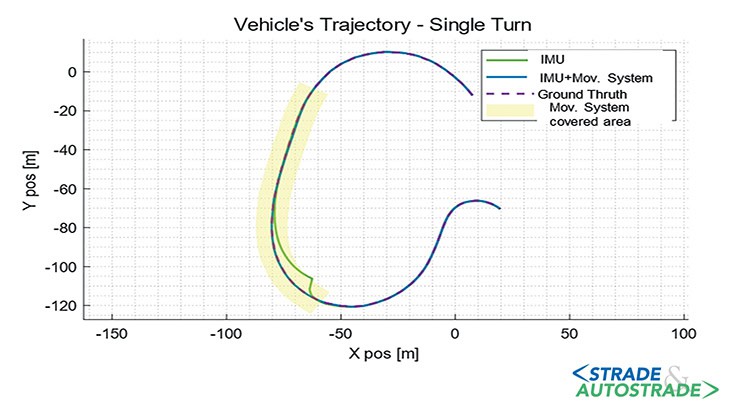
The results are encouraging: the accuracy of the location measurements is better than 30 cm in 95% of cases and average latencies are comparable with on board systems minimum requirements [3].
In particular, Figure 4, which is based on the circuit tests, shows a simulated loss of GNSS signal within the area covered by the devised positioning system: it is clear that the inertial unit in the vehicle (i.e. IMU) alone cannot ensure accurate positioning unless it receives additional information from the infrastructure, demonstrating how effective this type of advanced C-ITS service is.
The first autonomous driving test on the motorway with open traffic
With the help of the Osservatorio Tecnico di Supporto per le Smart Road e per il Veicolo Connesso e a Guida Automatica (Technical Observatory for the Support of Smart Roads, Connected Vehicles and Automated Driving) of the Italian Ministry of Infrastructure and Transport, Politecnico di Milano has recently obtained authorization for open-traffic testing pursuant to Italian Ministerial Decree 70/2018, better known as the Smart Road Decree.
With Autostrade per l’Italia, the first and only motorway concessionaire in Italy to grant clearance to drive on one of its routes, Movyon has already carried out two open-traffic tests in 2023, as shown in Figure 5.
To complement the trials, the system will be installed and some tests in open traffic are planned for the coming months, including in a tunnel. The main goal of the trial was to demonstrate that the infrastructure is capable of providing position information that enables vehicles to navigate autonomously in tunnels and other areas without GNSS coverage.
This is possible using positioning information provided by the infrastructure, that thanks to the Movyon solution, adopt an active role in the development of autonomous driving.
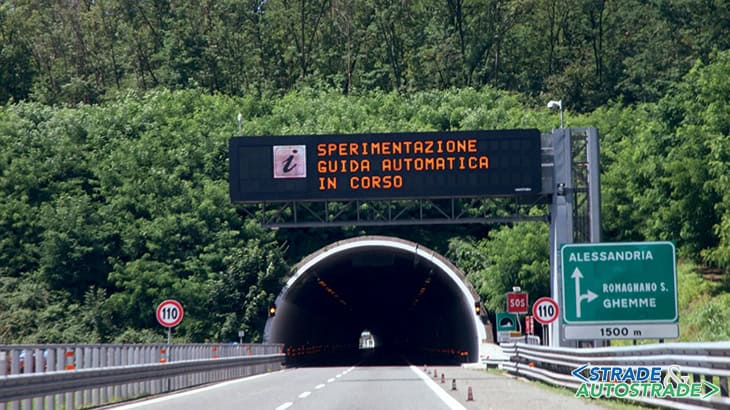
References
[1]. Detecon Analysis, ACEA, OICA, McKinsey, Deloitte: “CAVs & CAM are defined as level 3-5 as per SAE definitions”.
[2]. Augmented CCAM: “Augmenting and Evaluating the Physical and Digital Infrastructure for CCAM deployment”.
[3]. Tyler G. R. Reid, Sarah E. Houts, Robert Cammarata, Graham Mills, Siddharth Agarwal, Ankit Vora, & Gaurav Pandey: “Localization Requirements for Autonomous Vehicles”.
![]() Per la versione in Italiano: https://www.stradeeautostrade.it/its-smart-road/sperimentazioni-guida-autonoma-a-traffico-aperto/
Per la versione in Italiano: https://www.stradeeautostrade.it/its-smart-road/sperimentazioni-guida-autonoma-a-traffico-aperto/

